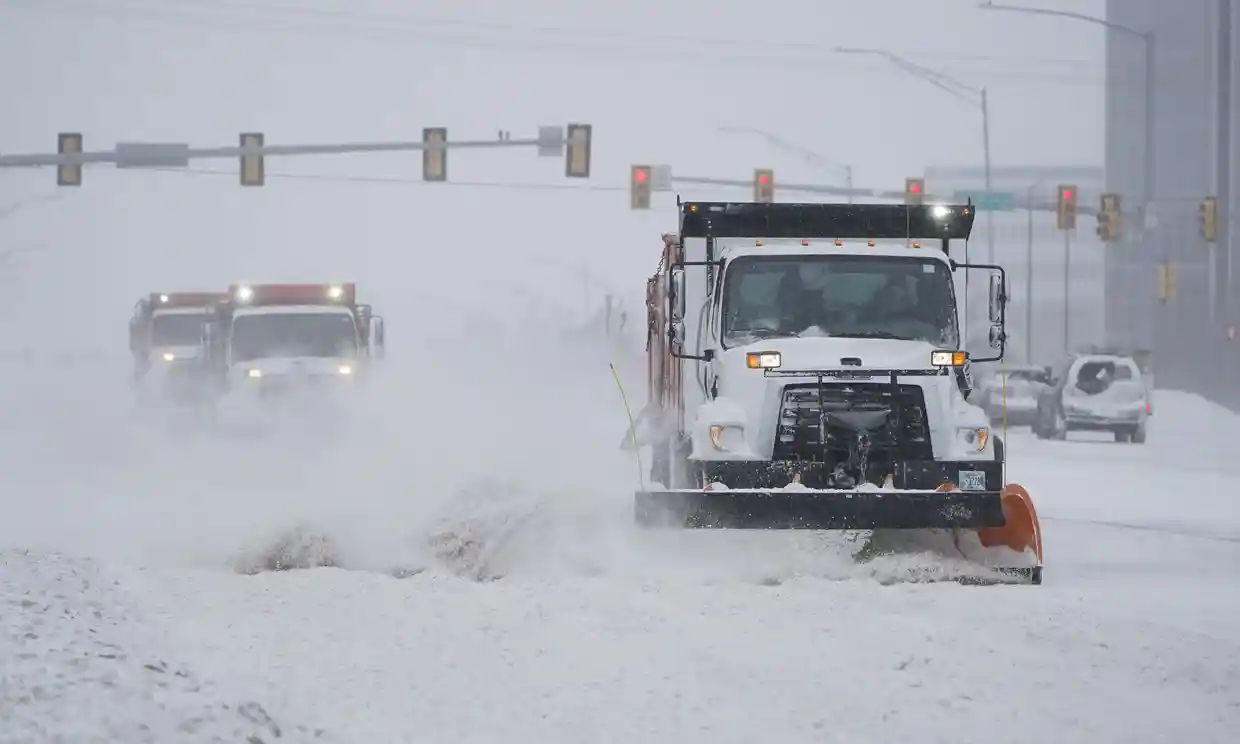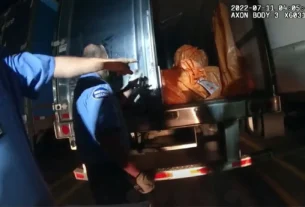Read the story at The Guardian
When Neil Crittenden heard that an extreme winter storm was about to hit Oklahoma last winter, he did what officials advised him to do and kept his heat on and water running so that his pipes wouldn’t freeze. The 40-year-old Oklahoma City resident even used hair dryers to keep them thawed.
What Crittenden didn’t know at the time was that the energy he used was going to cost him significantly. As winter storm Uri swept across the south central US last February, utilities that weren’t prepared scrambled. The storm caused blackouts in several states and resulted in the deaths of at least 223 people.
Oklahoma’s gas supply was in dire straits, with demand surging and the cold freezing critical equipment. To keep the heat on, the state’s biggest gas company, Oklahoma Natural Gas, made a last-minute decision: it purchased fuel from the wildly expensive spot market at nearly 600 times the usual price.
Now, nearly a year later, officials say residents like Crittenden have to foot the entire $1.37bn bill. The state’s utility regulator, the Oklahoma Corporation Commission, is expected to approve the plan later this month.
“Imagine if you went to the gas station and filled up $50 of gas for your car based on the prices the sign says. And then two months later, you get told you actually have to engage in a payment plan to pay off a 1,000 times that price,” Crittenden said.
Instead of challenging the prices the utility and its customers were charged, Oklahoma is readying a plan to use securitization – which works similar to a credit card – to cover the debt. It will pay off the $1.4bn, plus interest, by charging customers as much as $7.80 a month over the next 25 years.
Many states have used securitization to cover climate-related costs, like repairing downed power lines after a hurricane. But it has rarely been used for fuel costs. Energy and economics experts say it can be misused to prop up unprepared energy systems that are being tested by worsening extreme weather.
“It sets the precedent that there can be basically no upper limits to the cost of gas that would be passed on to a consumer,” said Kylah McNabb, an energy consultant and a former policy adviser to Oklahoma’s secretary of energy and environment under the former Republican governor Mary Fallin.
“That’s scary to me as a consumer.”
Consumer watchdogs are wondering why Oklahoma Natural Gas wasn’t better prepared – with emergency fuel contracts or weatherized power plants. And they want to know who is profiting off the $1.4bn – a matter state regulators have agreed to keep secret.
They say state leaders haven’t adequately questioned the charges and have instead rushed to make a plan to pay off the debt – in part because the oil and gas industry is so powerful in Oklahoma. The state is the fourth biggest producer of gas in the country.
Critics say Oklahoma’s story is part of a national trend of regulators failing to challenge the industries they oversee, as climate change worsens and extreme weather becomes more common.
“Regulators wield tremendous power over energy policy in the United States, but too often defer to the very utilities they are supposed to regulate. Weak regulation means higher rates for consumers and more carbon pollution,” said Charlie Spatz, a researcher at Energy and Policy Institute, a utility watchdog.
Oklahoma leaders counter they are getting customers a good deal, ensuring a lower interest rate from banks by charging a flat fee on monthly power bills, regardless of how much energy a customer used during the storm. They are also mandating a $687 “exit fee” for gas customers who opt to switch from using gas for heating and cooking to electric.
Oklahoma Natural Gas says it was prepared for the storm, in part because it had purchased gas at lower costs in the summer and put it in storage for the winter. In a statement it said the exit fee was not meant to be punitive and would “ensure that all customers pay their fair share”.
The Corporation Commission said regulators could not comment on pending cases. But one commissioner, Republican Bob Anthony, has signaled his discontent with the way the governing body has voted on recent securitization cases stemming from the storm.
“[The commissioners] have the right to hold any of these companies in contempt, and you have the right to examine their records at any time – we have the right to demand special reports,” Anthony said.
He recently voted against allowing an Oklahoma electric utility to pursue securitization. The other two Republican commissioners approved the request.
“I’m disappointed when people want to, ‘go along and get along’, because we are here to provide justice,” Anthony said. “I don’t think my job as a commissioner is to impose extensive interest obligations on ratepayers.”
When in debt
State officials warned Oklahomans about higher prices in the lead-up to the winter storm, but no one expected they could surge from $2 to $3 per thousand cubic feet to almost $1,200. Oklahoma’s price increases were among the highest in the region, three times higher than spot prices at neighboring fuel trading locations in Houston, according to the Energy Information Administration.
Monthly bills were projected to be in the thousands. State leaders recognized that would cause extreme hardship. Oklahoma has the eighth-highest poverty rate in the country and was already struggling to recover from the coronavirus pandemic.
Nearly a week after the storm hit, the state’s then attorney general, Mike Hunter, announced that he was looking into evidence of market manipulation by utilities. His findings could have forced the gas companies involved to reduce their charges to the utility and its customers. But a few months later an extramarital affair forced him to step down, and his replacement John O’Connor has since focused largely on challenging federal Covid-19 vaccination regulations and resuming the state’s death penalty.
When state legislators formed a special committee to review the storm costs, Oklahomans hadn’t been billed for the massive fuel costs, so they weren’t engaged.
Legislators introduced the securitization bill in early April 2021. The governor signed it into law on 23 April. It was meant to be just one option, but lawmakers and regulators at the Corporation Commission never revisited whether Oklahoma Natural gas customers should have to pay the $1.4bn.
Ashok Gupta, senior energy economist at the environmental group Natural Resources Defense Counsel, said that was “a failure of the regulatory body to do its job effectively even from a procedural point of view”.
Other state’s regulators have rejected utility requests to cover debt from storm Uri. In Minnesota, officials denied a gas utility’s request to recover $500m. A small town in south-eastern Kansas sued BP Energy in March for price gouging.
Oklahoma regulators have clawed back money from natural gas utilities before when they thought they overpaid for fuel. After a 2002 cold snap, the Corporation Commission required Oklahoma Natural Gas to refund $34m to customers.
Oklahomans have pushed back on the bill increases they have been told to expect.
Fern McIntosh of Tulsa, in response to a call for public comment, pleaded with policymakers.
“I am a low-income retired lady … I barely eat now,” she said.
Who is profiting?
Consumer advocates have charged that regulators are too close with the industry they oversee. Recent reports point out that the Corporation Commission’s three elected officials have each received more than $200,000 in campaign donations from employees, subsidiaries or political action committees tied to the companies they regulate, according to campaign finance reports.
Two commissioners, Todd Heitt and Dana Murphy, did not respond to a request for comment about their campaign donations. Anthony said his votes were independent and that his voting record had shown that.
Two days after the historic February storm, Oklahoma Natural Gas submitted a “protective order” to keep private the names of gas companies that benefited from the price spike. The Corporation Commission, which oversees utilities, agreed within 48 hours. Oklahoma Natural Gas said its request for a confidentiality provision with its suppliers was “industry standard”.
But the huge price surge – more than 600 times the normal prices – has led to calls for greater transparency.
The Corporation Commission’s public utility division, which operates independently from its elected commissioners, has filed a request to compel Oklahoma utilities to disclose their suppliers from during the storm.
“As a ratepayer, I would want to know, too,” said Brandy Wreath, director of that division.
But Wreath argued Oklahoma Natural Gas was not to blame for the costs, since it didn’t make money off gas sales, and he noted the attorneys and experts involved in the case were able to scrutinize who profited off the gas sale.
Wreath said the federal government was ultimately responsible for ensuring customers are protected in natural gas markets. The Federal Energy Regulatory Commission, which has been investigating possible price manipulation in the natural gas and electricity markets, found 14 suspicious trades but hasn’t identified them. That work is unlikely to be complete before Oklahoma’s deal is finalized.
Most Oklahomans became aware of the higher bills they would be paying only after receiving a November letter from the utility requesting them to weigh in on the plan already under way.
Paul Betow, a retired 61-year-old Muskogee resident who has lived in Oklahoma all of his life, had a grim take.
“They are trying to pass this off and make it average out for 28 years,” Betow said. “I will be dead in 28 years.”
This story is a collaboration of Floodlight and Oklahoma Watch.



